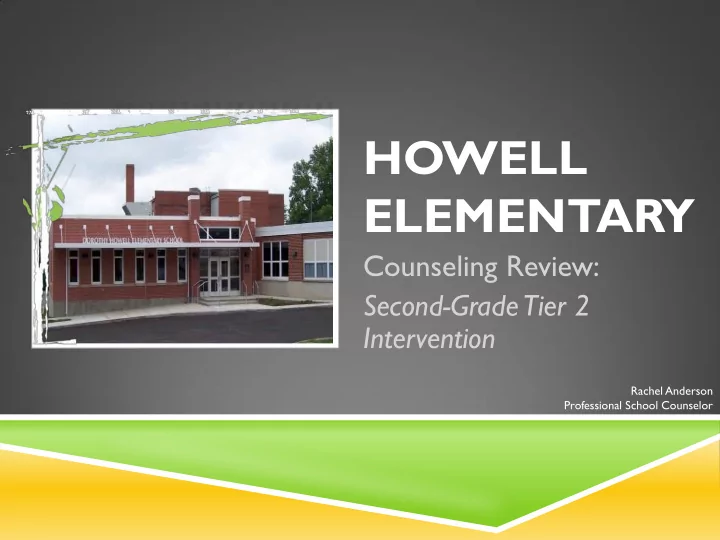

HOWELL ELEMENTARY Counseling Review: Second-Grade Tier 2 Intervention Rachel Anderson Professional School Counselor
CONTEXT Second-grade students are not at grade level academically. Second-grade students are not reaching the proficiency level in the PBIS realm of office behavior referrals. Teachers report behavior problems in their classroom, specifically that students in their classroom need improvement in the following areas: Social skills Problem-solving skills Metacognition skills
RATIONALE FOR INTERVENTION Group counseling has been shown to positively impact students’ academic achievement and personal growth (ASCA, 2014). A Tier 2 small-group intervention that focuses on social problem-solving skills will prepare the students to be more successful in the classroom, both academically and socially. Students will be selected based on office behavior referrals and teacher recommendations.
THE GOAL Reduce behavior referrals by 25% and increase teacher-reported social problem-solving skills by 15% as measured by pre-post evaluations in second-grade students identified as having issues with social skills, problem solving, and metacognition skills.
THE INTERVENTION Three groups of second-grade students met weekly for 10 weeks. One group of four girls T wo groups of five boys Pre and post evaluations for each student were given to their teachers in December 2014 and April 2015. Meetings lasted approximately 30 minutes each week. Response to Intervention They focused on the following topics: Tier 1 Identifying emotions (in ourselves and in others) Coping skills Overreactions vs. appropriate reactions Friendships Tier 2 Small Groups Conflicts Tier 3
RESULTS The following slides illustrate results of the Tier 2 social-problem- solving skills groups. Results are based on teacher pre-post evaluations (perception data) . Overall, the groups’ social -problem-solving skills total score on the post evaluation increased by 16%. Specifically, each of the following areas showed improvement and demonstrated statistical significance on a .05 level. Taking turns/sharing Working well in classroom Frequency of overreactions Involvement in fights Distracting other children Additionally, the office referral data indicates a 53% reduction in office behavior referrals (outcome data) .
RESULTS… Total scores of all post evaluations indicated a 16% increase in overall social problem-solving skills. Second-Grade Social-Problem-Solving Skills Group — Overall Sum of Evaluations 232 250 165 200 150 Score 100 50 0 Pre Post p = .00
RESULTS… Second-Grade Social-Problem-Solving Groups — Distracts Other Children Number of Students 10 8 6 9 4 1 2 3 Pre-Test 3 2 (Dec 2014) 3 0 Post-Test 0 1 (Apr 2015) 1 never 1 rarely sometimes usually always p = .02
RESULTS… Second-Grade Social-Skills Groups — Involvement in Fights 5 4.5 4 3.5 3 2.5 Pre-Test (Dec 2014) 2 1.5 Post-Test 1 (Apr 2015) 0.5 0 never rarely sometimes usually always p = .00
RESULTS… Second-Grade Social-Problem-Solving Groups — Frequency of Overreactions Number of Students 5 4 3 2 Pre-Test (Dec 2014) 1 Post-Test 0 (Apr 2015) never rarely sometimes usually always p = .02
RESULTS… Second-Grade Girls Social-Problem- Solving Group Pre-Test (Dec 2014) 2 Post-Test (Apr 2015) 1 0 never rarely sometimes usually always Shows Understanding of Others’ Feelings
RESULTS… Second-Grade Boys Social-Problem- Solving Groups 4 3 2 1 Pre-Test (Dec 2014) 0 Post-Test never (Apr 2015) rarely sometimes usually always Takes Turns/Shares
RESULTS… Additionally, our groups resulted in a 53% decrease in behavior referrals for group members. Second-Grade Social-Problem-Solving Skills Groups — Total Behavior Referrals 17 18 16 14 12 10 8 8 6 4 2 0 2nd quarter 3rd quarter
WHAT DOES THIS MEAN? We met our goal!!! Evidence shows that our Tier 2 intervention was successful. Social-problem-solving skills increased by 16%. Office behavior referrals were reduced by 53%. Teachers reported that group members showed improvement in each the following areas: Students that took part in our intervention are now LESS likely to Distract other children Become involved in fights Overreact to situations Students that took part in our intervention are now MORE likely to Show understanding of another person’s feelings Take turns/share
IMPLICATIONS Where do we go from here? Because the evidence indicates that our program was effective with second graders, there are multiple next steps that we can take. Attempt the same program with students in first and/or third grades. Repeat the program in the next school year for second-grade students. Repeat the program this year with a different group of second-grade students. Continue to collect data on successive groups. Further evaluate the impact of our program on other critical data elements, such as attendance, retention rates, and standardized test scores. Continue to educate our stakeholders about the impact of our counseling program. Communicate our results to other district school counselors at our monthly PLC meeting.
Recommend
More recommend